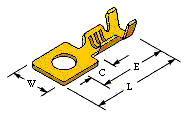

This very simple device rolls a small ball back and forth inside a clear straw. It was made to demostrate how Nitinol actuator wires continue working over a fixed range of motion for years. It operates about 20,000 cycles per day. It also happens to be a good way to introduce others to actuator wire
| Nitinol Rolling Ball | $24.95 |
 |
Another Nitinol demonstration of long life and durability, its
beautiful lifelike motion makes it a great gift as well. It may be used
with flowers in a lifelike setting or as a stand alone somewhere, perhaps
a computer top.
|

This is a fully functional electric valve made with Nitinol. It permits proportional control of the air or fluid flow. When voltage is applied the Nitinol inside contracts, opening the valve.
| Nitinol valve | $17.95 |
| Nitinol Switch Covers | $55.00 |
| Nitinol Wire Loops | $35.00 |
Live Wire
| Fun and educational! It changes crystal structure as it is warmed or cooled, so that its basic properties are varied. One consequence is that it had a shape memory. You bend it while cold, then heat it, and it will straighten quite forcefully. You can modify the remembered shape by annealing the wire. While holding the wire with two pairs of pliers, choose a new shape and hold it in a candle flame until it is slightly red and stops trying to straighten. Dip it into ice water, then straighten it. Now when you heat it, it will "remember" the new shape in which it was annealed. You now have "trained" the wire. As you work with the wire, its performance will improve. |  |
| Live Wire |
|
 |
|
|
W = .156 L = .375 E = .290 C = .109 Insul. Size = .035 - .065 Stud Size / Diameter = .094 Stock Thk. = .012 Material and Finish = Brass |
W = .078 L = .047 H = .037 |
When Nitinol actuator wire is use per the following guidelines one can expect
the nitinol wire to last tens of millions of cycles. On the other hand, if
stresses and overheating due to higher current densities are imposed upon the
nitinol actuator wire, good motion may only be obtained for a few thousand or
few hundred cycles, depending upon the severity of the stresses induced. In many
cases, heating of the wire is accomplished by passing an electrical current
through the nitinol actuator wire. Care should be taken to heat, but not
overheat the actuator wire. The following chart provides guidelines to follow.
| Diameter Size (inches) | Resistance (Ohms/Inch) | Maximum Pull Force (gms.) | Approximate Current at Room Temperature (mA) | Contration Time (seconds) | Off Time 70º C Wire (seconds) |
| 0.006 | 1.3 | 330 | 400 | 1 | 2.0 |
| 0.008 | 0.8 | 590 | 610 | 1 | 3.5 |
| 0.010 | 0.5 | 930 | 1000 | 1 | 5.5 |
| 0.012 | 0.33 | 1250 | 1750 | 1 | 8.0 |
| 0.015 | 0.2 | 2000 | 2750 | 1 | 13.0 |
Please note contraction time is directly related to electric current imposed.
The guidelines are only approximations, since other factors like ambient
temperature, air currents, and heat sinking will vary with specific devices.
| Diameter Size (inches) | Maximum Pull Force (gms.) | Unit Price |
| 0.006 | 330 | $5.00 / ft |
| 0.008 | 590 | $5.00 / ft |
| 0.010 | 930 | $5.00 / ft |
| 0.012 | 1250 | $7.50 / ft |
| 0.015 | 2000 | $12.50 / ft |

Note: Crimps cannot be sold as stand alone units. |
| Nitinol Booklet | $ 7.50 |
This internal "solid state" restructuring can be applied to any task requiring physical movement in confined places with low to moderate cycling speeds. The small size, low power requirements, ease of use, silent operation and low cost of Nitinol wires outshine that of any small motor or solenoid, and can be easily integrated into existing designs.
Some advantages of using Nitinol inlcude: